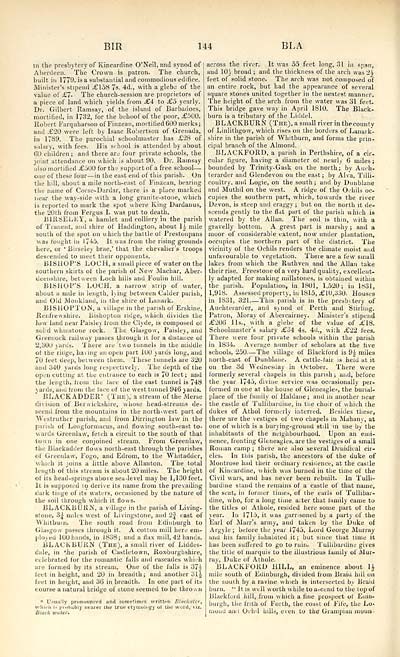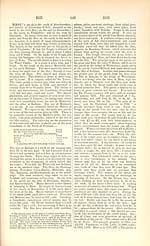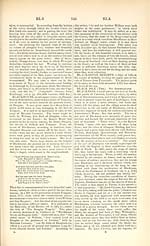Topographical, statistical, and historical gazetteer of Scotland > Volume 1
(224) Page 144 - BIR
Download files
Complete book:
Individual page:
Thumbnail gallery: Grid view | List view

BIR
144
BLA
in the presbytery of Kincardine O'Neil, and synod of
Aberdeen. The Crown is patron. The church,
built in 1779. is a substantial and commodious edifice.
Minister's stipend £158 7s. 4d., with a glebe of the
value of £7- The church-session are proprietors of
a piece of land which yields from £4 to £5 yearly.
Dr. Gilbert Ramsay, "of the island of Barbadoes,
mortified, in 1732, for the behoof of the poor, £500.
Robert Farquharson ofFinzean, mortified 600 merks;
and £20 were left by Isaac Robertson of Grenada,
in 1789. The parochial schoolmaster has £28 of
salary, with fees. His school is attended by about
60 children ; and there are four private schools, the
joint attendance on which is about 90. Dr. Ramsay
also mortified £500 for the support of a free school —
one of these four — in the east end of this parish. On
the hill, about a mile north-east of Finzean, bearing
the name of Corse-Dardar, there is a place marked
near the way-side with a long granite-stone, which
is reported to mark the spot where King Dardanus,
the 20th from Fergus I. was put to death.
B1RSELEY, a hamlet and colliery in the parish
of Tranent, and shire of Haddington, about 1^ mile
south of the spot on which the battle of Prestonpans
was fought in 1745. It was from the rising grounds
here, or 'Birseley brae,' that the chevalier's troops
descended to meet their opponents.
BISHOP'S LOCH, a small piece of water on the
southern skirts of the parish of New Machar, Aber-
deenshire, between Loch hills and Foulin hill.
BISHOP'S LOCH, a narrow strip of water,
about a mile in length, lung between Calder parish,
and Old Monklaml, in the shire of Lanark.
B1SHOPTON, a village in the parish of Erskine,
Renfrewshire. Bishopton ridge, which divides the
low land near Paisley from the Clyde, is composed ol
solid whinstone rock. The Glasgow, Paisley, and
Greenock railway passes through it for a distance ol
2, SOU \ards. There are two tunnels in the middle
ot the ridge, having an open part 1U0 jards long, and
70 teet deep, between them. These tunnels are 320
and 340 yards long respectively. The depth of the
open cutting at the entrance to each is 70 feet; and
the length, fioui the lace of the east tunnel is 748
yards, and from the lace of the west tunnel 946 yards.
BLACKADDER* (The), a stream of the Merse
division of Berwickshire, whose head-streams de-
scend from the mountains in the north-west part of
Westruther parish, and from Dirrington law in the
parish of Longformacus, and flowing south-east to-
wards Greenlaw, fetch a circuit to the south of that
town in one conjoined stream. From Greenlaw,
the Blackadder flows north-east through the parishes
of Greenlaw, Fogo, and Edrom, to the Whitadder,
which it joins a little above Allanton. The total
length of this stream is about 20 miles. The height
of its head-springs above sea.level may be 1,130 feet.
It is supposed to derive its name from the prevailing
dark tinge of its waters, occasioned by the nature of
the soil through which it flows.
BLACKBURN, a village in the parish of Living-
stone, 3^ miles west of Livingstone, and 2J cast of
Whitburn. The south road from Edinburgh to
Glasgow passes through it. A cotton mill here em-
plo\ed 100 hands, in 1838; and a flax mill, 42 hands.
BLACKBURN (The), a small river of Liddes-
dale, in *,he parish of Castletown, Roxburghshire,
celebrated for the romantic falls and cascades which
are formed by its stream. One of the falls is 374
feet in height, and 20 in breadth; and another oil
feet in height, and 36 in breadth. In one part of its
course a natural bridge of stone seemed to be thrown
* Usually pronounced and sometimes written Etackutcr,
which i* probably nearer the true etymology ol the word, via.
Uiauk iculer.
across the river. It was 55 feet long, 31 in soan,
and 10j broad ; and the thickness of the arch was 24
feet of solid stone. The arch was not composed o"f
an entire rock, but had the appearance of several
square stones united together in the neatest manner.
The height of the arch from the water was 31 feet.
This bridge gave way in April 1810. The Black-
burn is a tributary of the Liddel.
BLACKBURN (The), a small river in the county
of Linlithgow, which rises on the borders of Lanark-
shire in the parish of Whitburn, and forms the prin-
cipal branch of the Almond.
BLACKFORD, a parish in Perthshire, of a cir-
cular figure, having a diameter ot nearly 6 miles ;
bounded by Trinity-Gask on the north; by Audi-
terarder and Glendevon on the east ; by Alva, Tilli-
coultry, and Logie, on the south ; and by Dunblane
and Muthil on the west. A ridge of the Ochils oc-
cupies the southern part, which, towards the river
Devon, is steep and craggy ; but on the north it de-
scends gently to the flat part of the parish which is
watered by the Allan. The soil is thin, with a
gravelly bottom. A great part is marshy ; and a
moor of considerable extent, now under plantation,
occupies the northern part of the district. The
vicinity of the Ochils renders the climate moist and
unfavourable to vegetation. There are a few small
lakes from which the Ruthven and the Allan take
their rise. Freestone of a very hard quality, excellent-
ly adapted for making millstones, is obtained within
the parish. Population, in 1801, 1,520; in 1831,
1,918. Assessed property, in 1815, £10,330. Houses
in 1831, 321. — This parish is in the presbytery of
Auchterarder, and synod of Perth and Stirling.
Patron, Moray of Abercairney. Minister's stipend
£206 lis., with a glebe of the value of £18.
Schoolmaster's salary £34 4s. 4(1., with £22 fees.
There were four private schools within the parish
in 1834. Average number of scholars at the five
schools, 250. — The village of Blackford is 9£ miles
north-east of Dunblane. A cattle-lair is held at it
on the 3d Wednesday in October. There were
formerly several chapels in this parish; and, before
the year 1745, divine service was occasionally per-
formed in one at the house of Gleneagles, the burial-
place of the family of Haldane ; and in another near
the castle of Tullibardine, in the choir of which the
dukes of Athol formerly interred. Besides these,
there are the vestiges of two chapels in Mahany, at
one of which is a burying-grouud still in use by the
inhabitants of the neighbourhood. Upon an emi-
nence, fronting Gleneagles, are the vestiges of a small
Roman camp ; there are also several Druidical cir-
cles. In this parish, the ancestors of the duke of
Montrose had their ordinary resilience, at the castle
of Kincardine, which was burned in the time of the
Civil wars, and has never been rebuilt. In Tulli-
bardine stand the remains of a castle of that name,
the scat, in former times, of the earls of Tullibar-
dine, who, for a long time alter that family came to
the titles oi Athole, resided here some part of the
year. In 1715, it was garrisoned by a party of the
Earl of Marr's army, and taken by the Duke of
Argyle; before the year 1745, Lord George Murray
and his family inhabited it; but since that time it
has been suffered to go to ruin. Tullibardine gives
the title of marquis to the illustrious family of Mur-
ray, Duke of Athole.
BLACKFORD HILL, an eminence about H
mile south of Edinburgh, divided from Brain hill on
the south by a ravine which is intersected by Braid
burn. "It is well worth while to ascend to the top of
Blackford hill, from which a fine prospect of Edin-
burgh, tlie frith of Forth, the coast of Fife, the Lo-
mond any.1 Oclnl hills, even to the Grampian inuui><
144
BLA
in the presbytery of Kincardine O'Neil, and synod of
Aberdeen. The Crown is patron. The church,
built in 1779. is a substantial and commodious edifice.
Minister's stipend £158 7s. 4d., with a glebe of the
value of £7- The church-session are proprietors of
a piece of land which yields from £4 to £5 yearly.
Dr. Gilbert Ramsay, "of the island of Barbadoes,
mortified, in 1732, for the behoof of the poor, £500.
Robert Farquharson ofFinzean, mortified 600 merks;
and £20 were left by Isaac Robertson of Grenada,
in 1789. The parochial schoolmaster has £28 of
salary, with fees. His school is attended by about
60 children ; and there are four private schools, the
joint attendance on which is about 90. Dr. Ramsay
also mortified £500 for the support of a free school —
one of these four — in the east end of this parish. On
the hill, about a mile north-east of Finzean, bearing
the name of Corse-Dardar, there is a place marked
near the way-side with a long granite-stone, which
is reported to mark the spot where King Dardanus,
the 20th from Fergus I. was put to death.
B1RSELEY, a hamlet and colliery in the parish
of Tranent, and shire of Haddington, about 1^ mile
south of the spot on which the battle of Prestonpans
was fought in 1745. It was from the rising grounds
here, or 'Birseley brae,' that the chevalier's troops
descended to meet their opponents.
BISHOP'S LOCH, a small piece of water on the
southern skirts of the parish of New Machar, Aber-
deenshire, between Loch hills and Foulin hill.
BISHOP'S LOCH, a narrow strip of water,
about a mile in length, lung between Calder parish,
and Old Monklaml, in the shire of Lanark.
B1SHOPTON, a village in the parish of Erskine,
Renfrewshire. Bishopton ridge, which divides the
low land near Paisley from the Clyde, is composed ol
solid whinstone rock. The Glasgow, Paisley, and
Greenock railway passes through it for a distance ol
2, SOU \ards. There are two tunnels in the middle
ot the ridge, having an open part 1U0 jards long, and
70 teet deep, between them. These tunnels are 320
and 340 yards long respectively. The depth of the
open cutting at the entrance to each is 70 feet; and
the length, fioui the lace of the east tunnel is 748
yards, and from the lace of the west tunnel 946 yards.
BLACKADDER* (The), a stream of the Merse
division of Berwickshire, whose head-streams de-
scend from the mountains in the north-west part of
Westruther parish, and from Dirrington law in the
parish of Longformacus, and flowing south-east to-
wards Greenlaw, fetch a circuit to the south of that
town in one conjoined stream. From Greenlaw,
the Blackadder flows north-east through the parishes
of Greenlaw, Fogo, and Edrom, to the Whitadder,
which it joins a little above Allanton. The total
length of this stream is about 20 miles. The height
of its head-springs above sea.level may be 1,130 feet.
It is supposed to derive its name from the prevailing
dark tinge of its waters, occasioned by the nature of
the soil through which it flows.
BLACKBURN, a village in the parish of Living-
stone, 3^ miles west of Livingstone, and 2J cast of
Whitburn. The south road from Edinburgh to
Glasgow passes through it. A cotton mill here em-
plo\ed 100 hands, in 1838; and a flax mill, 42 hands.
BLACKBURN (The), a small river of Liddes-
dale, in *,he parish of Castletown, Roxburghshire,
celebrated for the romantic falls and cascades which
are formed by its stream. One of the falls is 374
feet in height, and 20 in breadth; and another oil
feet in height, and 36 in breadth. In one part of its
course a natural bridge of stone seemed to be thrown
* Usually pronounced and sometimes written Etackutcr,
which i* probably nearer the true etymology ol the word, via.
Uiauk iculer.
across the river. It was 55 feet long, 31 in soan,
and 10j broad ; and the thickness of the arch was 24
feet of solid stone. The arch was not composed o"f
an entire rock, but had the appearance of several
square stones united together in the neatest manner.
The height of the arch from the water was 31 feet.
This bridge gave way in April 1810. The Black-
burn is a tributary of the Liddel.
BLACKBURN (The), a small river in the county
of Linlithgow, which rises on the borders of Lanark-
shire in the parish of Whitburn, and forms the prin-
cipal branch of the Almond.
BLACKFORD, a parish in Perthshire, of a cir-
cular figure, having a diameter ot nearly 6 miles ;
bounded by Trinity-Gask on the north; by Audi-
terarder and Glendevon on the east ; by Alva, Tilli-
coultry, and Logie, on the south ; and by Dunblane
and Muthil on the west. A ridge of the Ochils oc-
cupies the southern part, which, towards the river
Devon, is steep and craggy ; but on the north it de-
scends gently to the flat part of the parish which is
watered by the Allan. The soil is thin, with a
gravelly bottom. A great part is marshy ; and a
moor of considerable extent, now under plantation,
occupies the northern part of the district. The
vicinity of the Ochils renders the climate moist and
unfavourable to vegetation. There are a few small
lakes from which the Ruthven and the Allan take
their rise. Freestone of a very hard quality, excellent-
ly adapted for making millstones, is obtained within
the parish. Population, in 1801, 1,520; in 1831,
1,918. Assessed property, in 1815, £10,330. Houses
in 1831, 321. — This parish is in the presbytery of
Auchterarder, and synod of Perth and Stirling.
Patron, Moray of Abercairney. Minister's stipend
£206 lis., with a glebe of the value of £18.
Schoolmaster's salary £34 4s. 4(1., with £22 fees.
There were four private schools within the parish
in 1834. Average number of scholars at the five
schools, 250. — The village of Blackford is 9£ miles
north-east of Dunblane. A cattle-lair is held at it
on the 3d Wednesday in October. There were
formerly several chapels in this parish; and, before
the year 1745, divine service was occasionally per-
formed in one at the house of Gleneagles, the burial-
place of the family of Haldane ; and in another near
the castle of Tullibardine, in the choir of which the
dukes of Athol formerly interred. Besides these,
there are the vestiges of two chapels in Mahany, at
one of which is a burying-grouud still in use by the
inhabitants of the neighbourhood. Upon an emi-
nence, fronting Gleneagles, are the vestiges of a small
Roman camp ; there are also several Druidical cir-
cles. In this parish, the ancestors of the duke of
Montrose had their ordinary resilience, at the castle
of Kincardine, which was burned in the time of the
Civil wars, and has never been rebuilt. In Tulli-
bardine stand the remains of a castle of that name,
the scat, in former times, of the earls of Tullibar-
dine, who, for a long time alter that family came to
the titles oi Athole, resided here some part of the
year. In 1715, it was garrisoned by a party of the
Earl of Marr's army, and taken by the Duke of
Argyle; before the year 1745, Lord George Murray
and his family inhabited it; but since that time it
has been suffered to go to ruin. Tullibardine gives
the title of marquis to the illustrious family of Mur-
ray, Duke of Athole.
BLACKFORD HILL, an eminence about H
mile south of Edinburgh, divided from Brain hill on
the south by a ravine which is intersected by Braid
burn. "It is well worth while to ascend to the top of
Blackford hill, from which a fine prospect of Edin-
burgh, tlie frith of Forth, the coast of Fife, the Lo-
mond any.1 Oclnl hills, even to the Grampian inuui><
Set display mode to: Large image | Transcription
Images and transcriptions on this page, including medium image downloads, may be used under the Creative Commons Attribution 4.0 International Licence unless otherwise stated. ![]()
| Gazetteers of Scotland, 1803-1901 > Topographical, statistical, and historical gazetteer of Scotland > Volume 1 > (224) Page 144 - BIR |
|---|
| Permanent URL | https://digital.nls.uk/97440234 |
|---|
| Description | Volume first. A-H. |
|---|---|
| Attribution and copyright: |
|

